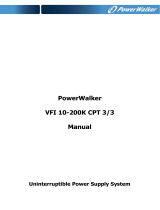
4. INSTALLATION.
4.1. IMPORTANT SAFETY INSTRUCTIONS..
Read the following safety instructions before installing
and starting up the equipment.
4.1.1. Transport.
Transport the UPS in the original packing (as protection from •
jolts and impacts).
4.1.2. Localiton.
Condensation problems could happen when moving the UPS •
from cold area to heat one. The UPS has to be perfectly dry be-
fore installing. Two hours of acclimatization should be allowed
as minimum.
Do not install the UPS close to water, wet or dust environ-•
ments.
Do not install the UPS in places exposed to direct sunlight or •
close to heat sources.
Do not block the cooling wholes of the UPS enclosure.•
4.1.3. Take care of your safety.
Equipment definition.•
Movable installation, class I, fed by an outlet type A and distri-
bution system TT (neutral regime is referred to earth).
Equipment with terminals: Fix installation, class I, permanent
connected and TT distribution (neutral regime is referred to
earth)
• The UPS can be connected and handled by staff
without any specific training, less those hardwired
models that will be installed by qualified staff and in
accordance with the regulations in force.
• Do not forget that the UPS is a generator of electric
energy, therefore the user has to take the needed
cautions against direct and indirect contacts.
Do not connect devices or loads at its outlets that can overload •
the UPS, like laser printers.
Put the cables in order to avoid tripping or stepping with them.•
Do not overload the equipment with domestic loads like hair-•
dryers, irons, etc...
The earth connection must be wired to the protection earth la-•
belled as ( ), making sure that it is done before turning on
the input voltage. For small devices (connected with power
cord with plug), the user has to make sure that the outlet cor-
responds with the supplied type, with earth connection com-
pletely isolated and connected to the local protective earth.
The UPS plug connected to the mains outlet, will have easy ac-•
cess and close to the equipment.
In those models with terminals a disconnection device has to be •
installed, with easy access and close to the equipment.
To connect the UPS to the mains and loads, use standardized •
cables and tested by an official organization only.
When installing the equipment, make sure that the sum of the •
earth leakage currents at the UPS output plus the connected
load/s do not overcome 3,5 mA.
4.1.4. Operating.
Do not disconnect the power cord plug of the UPS meanwhile •
the loads are turned on, because the earth connections of the
equipment and loads will be disconnected.
The UPS is characterized for having an internal current power •
supply (batteries). The UPS outlets can be alive electrically
although the UPS is disconnected from the installation of the
building physically.
Pay special attention to the labelling of the equipment that •
warns on «Electrical discharge danger» and stated as ( ).
Inside the equipment there are dangerous voltages, do not open •
the case, the access has to be done by authorised and compe-
tent staff. In case of maintenance or fault, consult the closest
STS (Service and Technical Support).
To disconnect the UPS completely, first press the OFF button, •
then disconnect the power cord cable in those models with plug
or turn Off the disconnection device close to the equipment (to
be installed and property by the customer), in those models
with terminals.
Make sure that objects or fluids cannot enter inside the UPS.•
4.1.5. Maintenance, service and faults.
The UPS works with dangerous voltages. The repair has to be •
done by qualified staff only.
Electrical shock risk. Although the unit is discon-
nected from the electrical mains, there are internal
parts in the UPS that are still connected to the bat-
teries, therefore they are both under voltage and dangerous.
Before doing any service and/or maintenance, disconnect the •
batteries and check that there is not any voltage in the termi-
nals capacitor bus (BUS-capacitors).
Only properly staff familiarized with the batteries and with the •
additional caution measures can replace them and supervise
the operations. Not authorized people should be kept away.
Electrocution risk. The battery circuit is not isolated
from the input voltage. Dangerous voltages can exist
between the battery and earth terminals. Before
touching, check that there is not any voltage present.
The batteries can cause electrocution and to produce a high •
shot-circuit current. Take the caution measures stated below
when working with batteries:
Take watches, rings and any metallic object off.
Use tools with insulated handles only and gloves.
During battery replacement, install the same number and type.•
Do not catch fire to the batteries. Explosion danger.•
Do not open or destroy the batteries. Electrolyte spillage can •
hurt eyes and skin. It can be toxic.






























